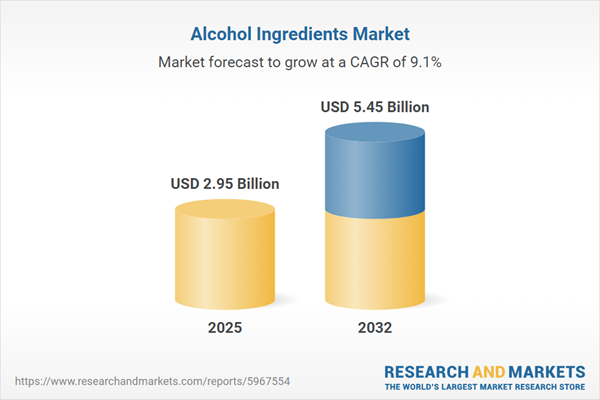Speak directly to the analyst to clarify any post sales queries you may have.
Senior executives in the alcohol ingredients sector require precise, current intelligence to make informed strategic decisions in an environment shaped by regulatory complexity, evolving consumer expectations, and technological advances. Reliable insights support organizational agility and position leaders to anticipate and respond to industry changes confidently.
Market Snapshot: Alcohol Ingredients Market Size, Growth & Trends
The global alcohol ingredients market reached USD 2.70 billion in 2024, reflecting a compound annual growth rate (CAGR) of 9.14%. Growth is driven by the increasing demand for premium and personalized beverages, which motivates producers to innovate with ingredient formulation. Manufacturers are expanding operations in emerging markets, led by shifts in production and consumption dynamics. The sector is witnessing a major pivot toward natural and functional ingredient profiles in response to health and wellness priorities. Heightened sustainability expectations impact both sourcing and manufacturing, while supply chains are being transformed for greater transparency and compliance with evolving standards.
Scope & Segmentation: Alcohol Ingredients Market
This report equips senior decision-makers with a detailed breakdown of the alcohol ingredients landscape, supporting both strategic direction and operational execution. The segmentation analysis facilitates targeted approaches for distinct stakeholder needs:
- Ingredient Types: Includes caramel colors (Classes I–IV), clarifying agents, enzymes, flavoring agents, nutrients, and stabilizers, supporting diverse beverage development and sensory differentiation.
- Applications: Covers beers, ciders, spirits, and wines, enabling customized product profiles tailored to distinct consumer and industry demands.
- Distribution Channels: Encompasses off-trade channels such as e-commerce and retail, along with on-trade hospitality, while digital platforms enhance supply chain visibility and efficiency.
- Form: Available as granules, powders, and liquids, supporting both automated high-volume production and smaller-scale flexible operations.
- End Users: Applies to breweries, distilleries, cideries, and wineries, ranging from major international firms to specialized local producers, all relying on robust sourcing and distribution frameworks.
- Regional Coverage: Spans the Americas, Europe, Middle East & Africa, and Asia-Pacific. Special consideration is given to China, India, South Korea, and Southeast Asia, which are experiencing rapid changes in consumption patterns and ingredient preferences.
- Company Profiles: Features Givaudan SA, International Flavors & Fragrances Inc., Symrise AG, Kerry Group plc, Sensient Technologies Corporation, Tate & Lyle plc, Archer-Daniels-Midland Company, Ingredion Incorporated, Chr. Hansen Holding A/S, and Koninklijke DSM N.V., highlighting progress in product innovation, digitization, and operational excellence.
Key Takeaways for Senior Decision-Makers
- Sustainable sourcing and clean-label ingredient initiatives improve brand credibility while supporting compliance as consumer expectations evolve.
- Digital transformation in new ingredient development and compliance management allows for rapid adjustment and comprehensive oversight across complex global supply chains.
- Building strong partnerships with suppliers and production teams accelerates the delivery of innovative ingredient solutions that align with evolving market demands.
- Diversifying the supplier network and adopting flexible manufacturing approaches help mitigate risks from regional disruptions and meet varied product requirements.
- Adaptive go-to-market strategies that incorporate local regulations and changing consumer behavior support compliance and efficient market access.
- Integrated digital commerce solutions strengthen operational resilience, enabling both established industry leaders and emerging players to capture opportunities as the market evolves.
Tariff Impact: Navigating United States Regulatory Shifts
Recent adjustments to United States tariff policy have increased costs for key inputs such as stabilizers and flavoring agents. To address these shifts, industry participants are reinforcing local supply chains, focusing investments on domestic capacity, and optimizing manufacturing processes to maintain business continuity while aligning with more stringent regulatory and innovation standards.
Methodology & Data Sources
This report is built on executive-level interviews, comprehensive sector surveys, and thorough regulatory review. Sector specialists validate conclusions to assure relevance and actionable value for decision-makers in the alcohol ingredients industry.
Why This Report Matters for Senior Leaders
- Facilitates effective adaptation to shifts in market cycle, product innovation, and sales channel expansion.
- Strengthens risk management throughout global supply chains and streamlines compliance in a complex regulatory environment.
- Enables prioritization of resources and early identification of high-potential growth or innovation segments.
Conclusion
This report provides senior decision-makers with the clarity and strategic insight necessary to strengthen operational agility and support sustainable growth in the dynamic alcohol ingredients sector.
Additional Product Information:
- Purchase of this report includes 1 year online access with quarterly updates.
- This report can be updated on request. Please contact our Customer Experience team using the Ask a Question widget on our website.
Table of Contents
3. Executive Summary
4. Market Overview
7. Cumulative Impact of Artificial Intelligence 2025
Companies Mentioned
The companies profiled in this Alcohol Ingredients market report include:- Givaudan SA
- International Flavors & Fragrances Inc.
- Symrise AG
- Kerry Group plc
- Sensient Technologies Corporation
- Tate & Lyle plc
- Archer-Daniels-Midland Company
- Ingredion Incorporated
- Chr. Hansen Holding A/S
- Koninklijke DSM N.V.
Table Information
| Report Attribute | Details |
|---|---|
| No. of Pages | 182 |
| Published | October 2025 |
| Forecast Period | 2025 - 2032 |
| Estimated Market Value ( USD | $ 2.95 Billion |
| Forecasted Market Value ( USD | $ 5.45 Billion |
| Compound Annual Growth Rate | 9.1% |
| Regions Covered | Global |
| No. of Companies Mentioned | 11 |









